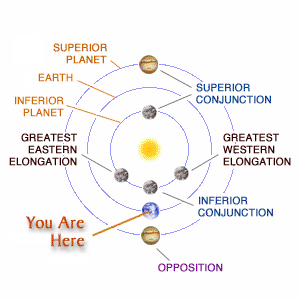 To better understand what inferior conjunction is, it is important to mention first how the planets are positioned in the Solar System according to how they orbit the Sun. Here is how the planets are arranged from the closest to the Sun outwards, these are the orbits of:
To better understand what inferior conjunction is, it is important to mention first how the planets are positioned in the Solar System according to how they orbit the Sun. Here is how the planets are arranged from the closest to the Sun outwards, these are the orbits of:
Mercury
Venus
Earth
Mars
Jupiter
Saturn
Uranus
Neptune
Pluto (now considered to have “dual citizenship” being a planet and a minor star)
When a planet is in a position that appears close to another planet or star, that planet is in conjunction. This actually happens all the time. As a planet is seen close to the Sun, it is said to be in solar conjunction. Simply put, a planet that is at solar conjunction has a similar right ascension as that of the Sun.
Based on a planets’ orbits, they are classified as inferior or superior planets. It would be interesting to take note that there are two planets that are labeled as inferior planets. They are named such because of how these two planets orbit in relation to Earth’s orbit. These planets are Mercury and Venus. The superior planets whose orbits are beyond the Earth’s are Mars, Jupiter, Saturn, Uranus, Neptune, and Pluto.
So how do all these relate to inferior conjunction? Here goes, there are two important points in the orbit of an inferior planet. If the inferior planet is at conjunction that is on the far side of the Sun, it is said to be at superior conjunction. On the other hand, if the planet is at conjunction on the Earth’s side of the Sun, it is at inferior conjunction. Take note that only the inferior planets, Mercury and Venus, experience inferior conjunctions.
Venus at Inferior Conjunction
